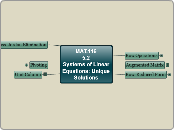по David Kedrowski 15 лет назад
410
MAT.116 5.2

по David Kedrowski 15 лет назад
410

Больше похоже на это
A column in a coefficient matrix is called a unit column if one of the entries in the column is a 1 and the other entries are zero.
A matrix formed from a system of linear equation where the equations are written in standard form with the variable terms written in the same order for each equation.
The matrix has a vertical line separating the coefficients from the left sides of the equations from the constants on the right sides of the equations.
The matrix of coefficients on the left side of the vertical line is called the coefficient matrix.